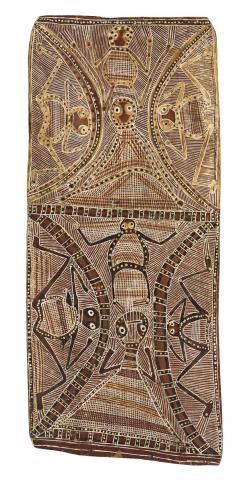MARALAITJ - WOMAN IS BORN, c.1967
YIRAWALA
natural earth pigments on eucalyptus bark
69.0 x 30.0 cm (irregular)
Executed at Minjilang, Croker Island, Western Arnhem Land
Private collection
For other examples by the artist depicting the same subject matter see: Sacred Frog, 1965, collection of the National Gallery of Australia, Canberra; and Maralatji, c1976, collection of the Museum of Contemporary Art, Sydney
Yirawala belonged to the Naborn clan on the Liverpool River. The recognised master of western Arnhem Land bark painting, he grew up learning the traditional ways of his culture from his father, Nowaritj, who taught him the songs, stories, designs and the meanings of the rock paintings in the western Arnhem Land rock escarpments. Yirawala endeavoured to use his art to preserve and continue local traditions and to inform the non-indigenous population of the richness and contemporary relevance of Aboriginal culture and law. 'Yirawala was a master at weaving different kinds of ceremonial designs into his bark paintings and was explicit about his desire to educate non-Indigenous audiences about the power of ancestral subjects. The power of the paint was a touchstone of the power of the ancestral beings who wore these designs on their bodies.'1
By the 1950s Yirawala was living on Minjilang (Croker Island) and was already an acknowledged senior ceremonial leader and bark painter. His earliest bark paintings were directly connected to the rock art of the western Arnhem escarpment. However, as he grew in ceremonial status, Yirawala began to paint detailed renditions of sacred body designs from ceremonies such as the Mardayin, Lorrkon and Wubarr.
This particular bark illustrates Maralaitj surrounded/bordered by duwa (frogs) and the intricate white crosshatching of Mardayin sacred design. 'Among the Kuninjku and some related groups in Arnhem Land, Maralaitj, also known as Warramurrungunjdji, is considered to be the first mother who gave birth to the ancestors of the peoples living in the region today. She possessed supernatural powers and in some versions of her story she did not require a man to conceive children.'2
1. Taylor, L., 'From Rock to Bark. Art from Western Arnhem Land', in They are Meditating: Bark paintings from the MCA's Arnott Collection, Museum of Contemporary Art, Sydney, 2008, p. 158
2. Cubillo, F, 'Yirawala', in Aboriginal and Torres Strait Islander Art: Collection Highlights, National Gallery of Australia, Canberra, 2010, p. 120
CRISPIN GUTTERIDGE
